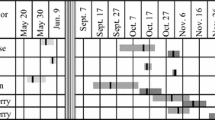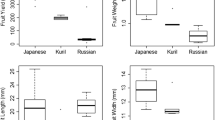Abstract
The blue honeysuckle (Lonicera caerulea L.) has outstanding features as a novel fruit crop, including extreme winter hardiness, resistance of flowers to severe frosts and early season phenology. Its northern climatic adaptation also limits its range of production. Therefore, crop enhancement requires development of germplasm with adaptation to temperate climatic regions suited to large-scale horticulture. In a cold continental climate, the University of Saskatchewan fruit breeding program utilizes a wide-cross breeding strategy to produce improved germplasm groups from foundation groups from Russia, Japan and the Kuril Islands. A key objective is to evaluate temperate climate adaptation in these improved groups compared to their parental foundation genotypes. In a temperate climate in the Fraser Valley, British Columbia, Canada, evaluation of spring phenology in 2012 and 2013 compared blue honeysuckle to blueberry, raspberry and strawberry. By determining the range of variation within improved groups and the general mode of gene action controlling phenological traits, the current study characterized methods to enhance temperate climate adaptation through breeding. The improved groups generated from wide crosses exhibited hybrid vigour for numerous traits, presenting opportunities for broadening the crop’s range of production. Selection for enhanced adaptation will be possible due to prevalence of intermediate types between the phenological extremes seen in the Russian and Kuril groups, moderation of these extremes by the Japanese group’s intermediate phenology through dominant and overdominant gene action and high broad-sense heritability. Long-term genetic gains are most feasible for combinations of Japanese and Kuril groups, especially in bloom phenology.



Similar content being viewed by others
References
Bates D, Maechler M, Bolker B, Walker S (2015) Fitting linear mixed-effects models using lme4. J Stat Softw 67(1):1–48
Bors B, Thomson J, Sawchuk E, Reimer P, Sawatzky R, Sander T, Kaban T, Gerbrandt E, Dawson J (2012) Haskap breeding and production, Final report to Saskatchewan Agriculture, Agriculture Development Fund, Regina. http://www.agriculture.gov.sk.ca/apps/adf/ADFAdminReport/20080042.pdf. Accessed on 06 Jan 2016
Esichev ST (2009) The results of studies of blue honeysuckle cultivars bred in Siberian and grown on Kaluga State variety plot. In: Proceedings of the 1st Virtual International Scientific Conference on Lonicera caerulea L., pp 155–157
Fernald ML, Kinsey AC (1943) Edible Wild Plants of Eastern North America. Idlewild Press, New York, pp 344–345
Golovunin VP (2009) Honeysuckle introduction in Marii El Republic. In: Proceedings of the 1st Virtual International Scientific Conference on Lonicera caerulea L., pp 152–154
Graves S, Piepho H-P, Selzer L, Dorai-Raj S (2015) multcompView: visualizations of paired comparisons. https://CRAN.R-project.org/package=multcompView. Accessed on 03 Jan 2015
Mucina L (1997) Conspectus of classes of European vegetation. Folia Geobot 32:117–172
Nakajima F (1996) Small fruit growing in Hokkaido. Hokkaido Prefecture Agricultural Extension Services, Extension Publication, Sapporo
Peel MC, Finlayson BL, McMahon TA (2007) Updated world map of the Köppen-Geiger climate classification. Hydrol Earth Syst Sci 11:1633–1644
Plekhanova MN (1986) Lonicera kamtchatica (Sevast.) Pojark. on Iturup Island and prospective for its utilization. Plant Nat Resour 22:99–106
Plekhanova MN (2000) Blue honeysuckle (Lonicera caerulea L.)—a new commercial berry crop for temperate climate: genetic resources and breeding. Acta Hort (ISHS) 538:159–164
Plekhanova MN, Rostova RS (1994) The analysis of variability of morphological, anatomical and biochemical characters of Lonicera in subsection Caeruleae (Caprifoliaceae) with the help of the method of principal components. Bot Zhurnal 79(2):45–64
Pojarkova AI (1958) Honeysuckle—Lonicera. In: Schischkin VK (ed) Flora of the USSR Volume 23: Bignoniaceae—Valerianaceae. Akademiya Nauk SSSR, Moscow, pp 446–482
Rudenberg L, Green P (1969) A karyological survey of Lonicera, II. J Arnold Arbor 50:449–451
Ryabinina ML (2009) Collection of blue fruited honeysuckle in the Botanical Gardens of Komi Institute of Biology. In: Proceedings of the 1st Virtual International Scientific Conference on Lonicera caerulea L., pp 69–72
R Development Core Team (2015) R: a language and environment for statistical computing, R Foundation for Statistical Computing, Vienna. http://www.Rproject.org Accessed 01 Jan 2015
Sabitov A (1986) Species of blue fruited honeysuckle, prospects for breeding. All Union Order of Lenin and Order of Friends of Nature Science Research Institute of Plant Growing, Leningrad
Sheyko VV (2009) Honeysuckle response (Lonicera caerulea L.) to excessively wet and cold temperate climate. In: Proceedings of the 1st Virtual International Scientific Conference on Lonicera caerulea L., pp 75–83
Skvortsov AK (1986) Blue honeysuckle (Lonicera subsect. Caeruleae) of Eurasia: Distribution, taxonomy, chromosome numbers, domestication. Acta Univ. Ups. Symb. Bot. Upsal 27(2):95–105
Stepanova NN (2009) Honeysuckle culture in Priamurye. In: Proceedings of the 1st Virtual International Scientific Conference on Lonicera caerulea L., pp 138–143
Suchkova SA and Senina EG (2009) Studies on honeysuckle cultivars in Tomsk region. In: Proceedings of the 1st Virtual International Scientific Conference on Lonicera caerulea L., pp 165–168
The Weather Network 2015 Historical weather, British Columbia. www.theweathernetwork.com/ca/weather/historical-weather/. Accessed on 08 Jan 2015
Thompson MM (2006) Haskap arrives in North America. Pome. New. 31(3): 65–69
Thompson MM, Barney DL (2007) Evaluation and breeding of Haskap in North America. J Am Pomol Soc 61(1):25–33
Acknowledgements
The authors thank Maxine Thompson (Oregon State University), Maria Plekhanova (Vavilov Institute) and Jim Gilbert (One Green World Nursery) for providing the foundation blue honeysuckle germplasm used in this study. EMG was a grateful recipient of the Natural Science and Engineering Research Council of Canada’s Alexander Graham Bell Canada Graduate and Vanier Canada Graduate Scholarships and the Robert P. Knowles Plant Breeding Scholarship (Grants M.Sc. Scholarship and Ph.D. Scholarship).
Author information
Authors and Affiliations
Corresponding author
Additional information
Part of a Ph.D. thesis (EMG) submitted to the University of Saskatchewan.
Rights and permissions
About this article
Cite this article
Gerbrandt, E.M., Bors, R.H., Chibbar, R.N. et al. Spring phenological adaptation of improved blue honeysuckle (Lonicera caerulea L.) germplasm to a temperate climate. Euphytica 213, 172 (2017). https://doi.org/10.1007/s10681-017-1958-5
Received:
Accepted:
Published:
DOI: https://doi.org/10.1007/s10681-017-1958-5




